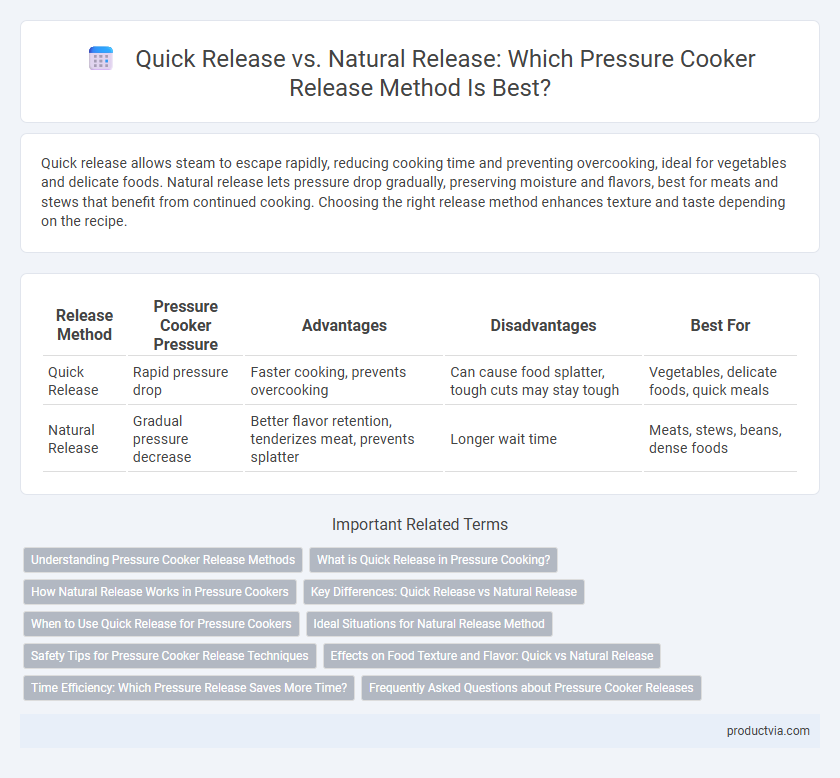Quick release allows steam to escape rapidly, reducing cooking time and preventing overcooking, ideal for vegetables and delicate foods. Natural release lets pressure drop gradually, preserving moisture and flavors, best for meats and stews that benefit from continued cooking. Choosing the right release method enhances texture and taste depending on the recipe.
Table of Comparison
| Release Method | Pressure Cooker Pressure | Advantages | Disadvantages | Best For |
|---|---|---|---|---|
| Quick Release | Rapid pressure drop | Faster cooking, prevents overcooking | Can cause food splatter, tough cuts may stay tough | Vegetables, delicate foods, quick meals |
| Natural Release | Gradual pressure decrease | Better flavor retention, tenderizes meat, prevents splatter | Longer wait time | Meats, stews, beans, dense foods |
Understanding Pressure Cooker Release Methods
Quick release rapidly vents steam, reducing cooking time and preventing overcooking for delicate foods like vegetables. Natural release allows pressure to decrease gradually, ideal for tougher cuts of meat requiring gentle cooking to enhance tenderness. Understanding the benefits of each release method ensures optimal texture and flavor in pressure-cooked meals.
What is Quick Release in Pressure Cooking?
Quick release in pressure cooking is a method where the pressure inside the cooker is rapidly released by turning the pressure valve to vent steam immediately after cooking. This technique prevents overcooking by quickly stopping the cooking process, making it ideal for delicate foods like vegetables and seafood. Quick release also reduces the wait time compared to natural release, which allows pressure to dissipate gradually.
How Natural Release Works in Pressure Cookers
Natural release in pressure cookers allows the pressure to decrease gradually as the cooker cools down, preventing sudden pressure changes that can affect food texture. This method helps retain moisture and ensures even cooking, making it ideal for delicate foods like meats and soups. The pressure naturally dissipates through a built-in valve, resulting in tender, flavorful dishes without the risk of splattering.
Key Differences: Quick Release vs Natural Release
Quick Release rapidly reduces pressure by manually opening the valve, resulting in immediate steam release and faster cooking stop, ideal for delicate foods or preventing overcooking. Natural Release allows pressure to decrease gradually inside the cooker as it cools, preserving moisture and tenderness, suitable for tough cuts of meat or recipes requiring further cooking after sealing. Choosing between Quick Release and Natural Release depends on food type, texture desired, and timing preferences in pressure cooking.
When to Use Quick Release for Pressure Cookers
Quick release for pressure cookers is ideal when cooking delicate vegetables or seafood that require immediate pressure reduction to prevent overcooking. It is also used when quick access to the food is needed to stop the cooking process instantly, such as for pasta or rice dishes. Using quick release helps retain texture and prevents mushiness in foods sensitive to prolonged pressure exposure.
Ideal Situations for Natural Release Method
The natural release method is ideal for cooking foods that benefit from gradual pressure reduction, such as large cuts of meat, stews, and beans, where tenderizing and flavor melding are essential. This technique helps prevent toughening or splitting of delicate ingredients by allowing residual heat to finish the cooking process gently. It is also preferred when reducing the risk of hot steam burns, as pressure dissipates slowly without the immediate steam burst of quick release.
Safety Tips for Pressure Cooker Release Techniques
Quick Release rapidly lowers pressure by opening the valve, requiring caution to avoid steam burns; always use a long utensil and keep hands clear from the vent. Natural Release allows pressure to drop gradually, minimizing the risk of hot liquid splatter and is safer for foods prone to foaming or foaming over. Ensure the pressure indicator has fully dropped before opening the lid to prevent sudden steam exposure and potential injury.
Effects on Food Texture and Flavor: Quick vs Natural Release
Quick release rapidly reduces pressure, preserving the texture of delicate foods like vegetables and seafood by preventing overcooking and maintaining firmness. Natural release allows pressure to drop gradually, which enhances flavor development and tenderizes tougher cuts of meat by continuing the cooking process under residual heat. Choosing between quick and natural release directly impacts moisture retention, texture, and the depth of taste in pressure-cooked dishes.
Time Efficiency: Which Pressure Release Saves More Time?
Quick release pressure method rapidly vents steam, significantly reducing cooking cycle time and enabling faster meal preparation. Natural release lets pressure dissipate gradually, extending total cooking time but preserving moisture and texture in certain dishes. For maximum time efficiency, the quick release technique saves more time compared to natural release.
Frequently Asked Questions about Pressure Cooker Releases
Quick release in pressure cookers rapidly reduces pressure by manually venting steam, ideal for delicate foods needing immediate pressure drop. Natural release allows pressure to decrease gradually without intervention, preserving moisture and tenderness in dense or starchy dishes like beans and meats. Frequently asked questions often address when to use each method, safety concerns during steam release, and impact on cooking time and food texture.
Quick Release vs Natural Release for Pressure Cooker Pressure Infographic

 productvia.com
productvia.com